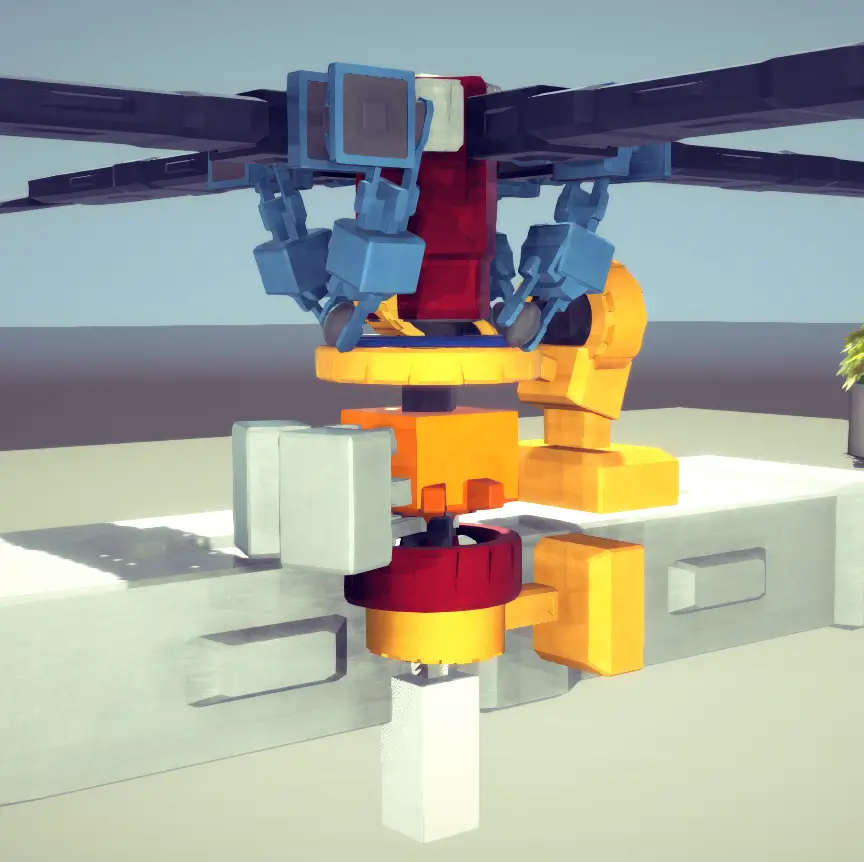The purpose of this guide is to serve as a comprehensive troubleshooting compendium aimed at optimizing the performance of a swashplate and ensuring its seamless functionality and aesthetic appeal. Please note that this guide focuses primarily on troubleshooting and tuning aspects rather than providing instructions for building the swashplate from scratch.
Example Design Description
The design presented here is the example used for demonstration purposes. Regardless of any differences between your specific design and this example, the guide retains its universal applicability and can provide valuable assistance in achieving a better result for your swashplate.


- White — static:
Top unpowered wheel supports the top of the mast (red scaling block) connected to the hidden base log with braces. 2 hinges provide additional support to the orange gear that powers the rotor. - Red — mast:
A tall scaling block is connected to the bottom wheel. The wheel’s “ADD PT” has priority, so the scaling block will only connect to the wheel. - Orange — engine:
Brace on a powered cog that provides power. - Blurple — swashplate:
A scaling block. Use joint flexibility to tilt. Stay in sync with the mast without complex constant velocity mechanisms or a high inertia axle block. - Yellow — swashplate control:
The yellow wheel is attached to the swashplate. The three hinges are for roll, pitch, and phase shift adjustment. - Blue — control rods:
Translates the swashplate pitch to the pitch of each blade. - Dark Grey — rotor blades:
Pitch allowed by the strong spinning block set to 0 speed and acceleration. A log for the replica visual. 3 id=’52’ propellers. 2 scaling blocks for the tip, the angled one has a low mass of 0.001 for visual, the mass of the other should be tuned.
Troubleshooting List
Format that we will use in this guide:
- + to increase | do this
- – to decrease | do this
Parts List:
Blade Flapping
- + | blade root block scale – |
- – | blade root block scale + |
Smaller blocks are more flexible
Dissymmetry of Lift
- + | tip mass + | flapping – | mast mass – |
| swashplate & control rods rigidity (mass and scale) – | - – | tip mass – | flapping + | mast mass + |
| swashplate & control rods rigidity (mass and scale) + |
When swashplate & control rods are rigid, the flapping of a blade naturally decreases the dissymmetry of lift.
Rotor Speed
- + | power + | power source block support + |
- – | power – | |
Swashplate Effectiveness
- + | swashplate end of control rod distance to center + |
| blade end of control rod distance to blade axle – | - – | swashplate end of control rod distance to center – |
| blade end of control rod distance to blade axle + |
Phase Shift
- + | tip mass + |
- – | tip mass – |
Ways of correcting phase shift:
- Rotate the whole swashplate control.
- Tilt the control rods so there’s a shift between the swashplate and blades
Vibration
- + | tip mass – | mast mass – |
- – | tip mass + | mast mass + |
That's everything we are sharing today for this Besiege guide. This guide was originally created and written by CCCanyon. In case we fail to update this guide, you can find the latest update by following this link.
